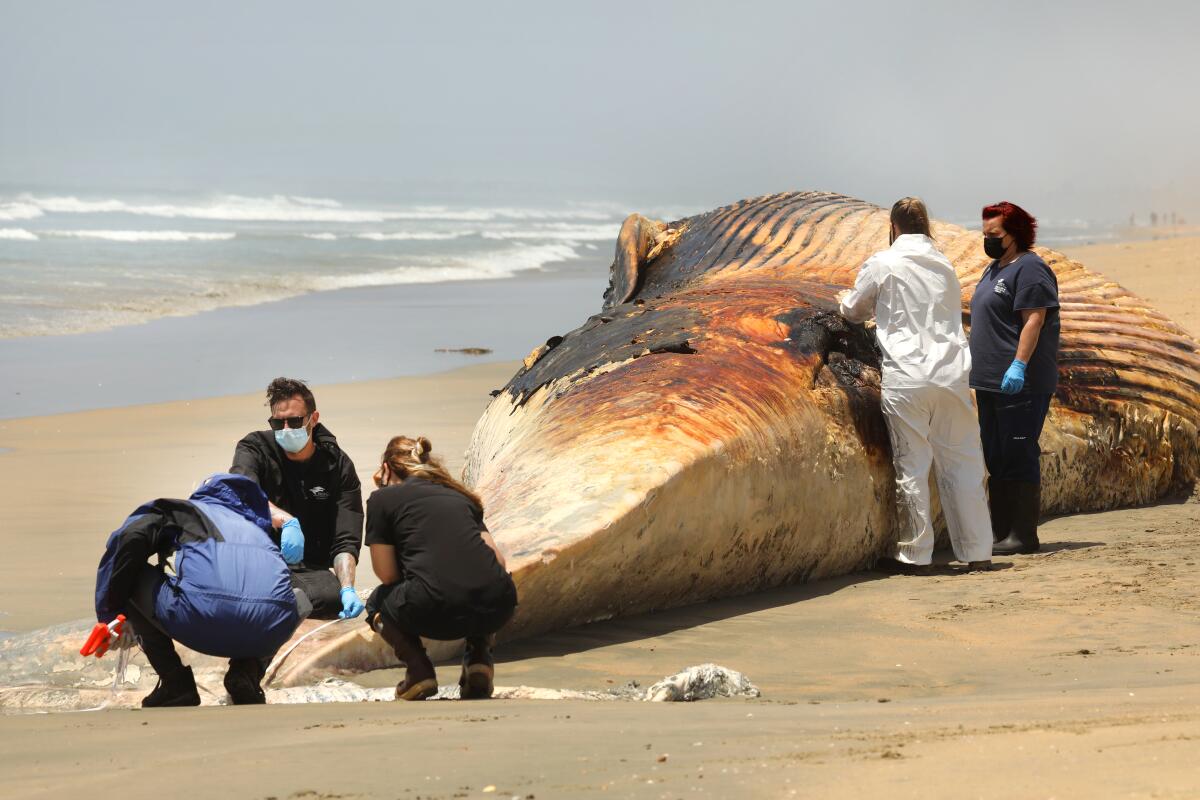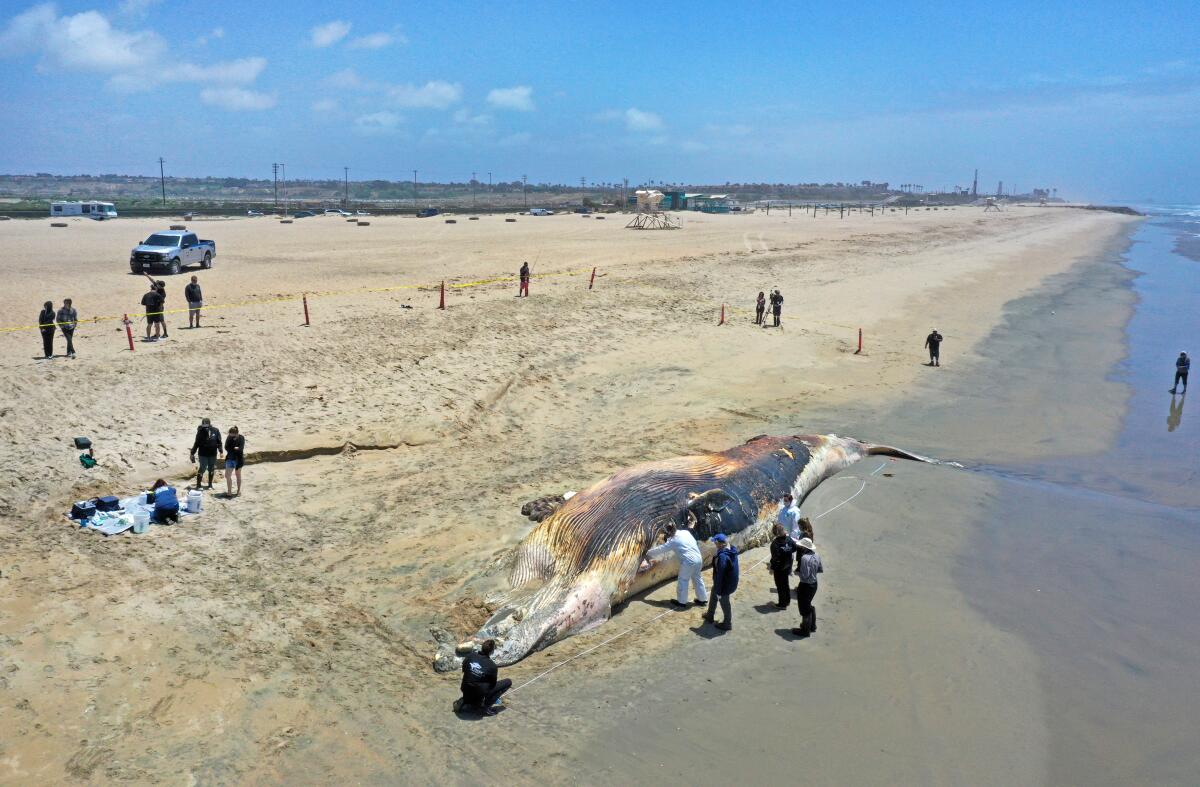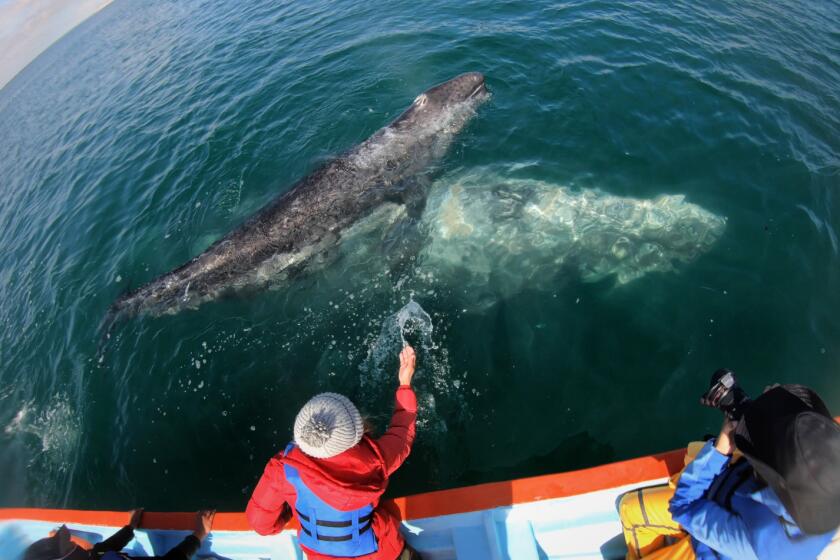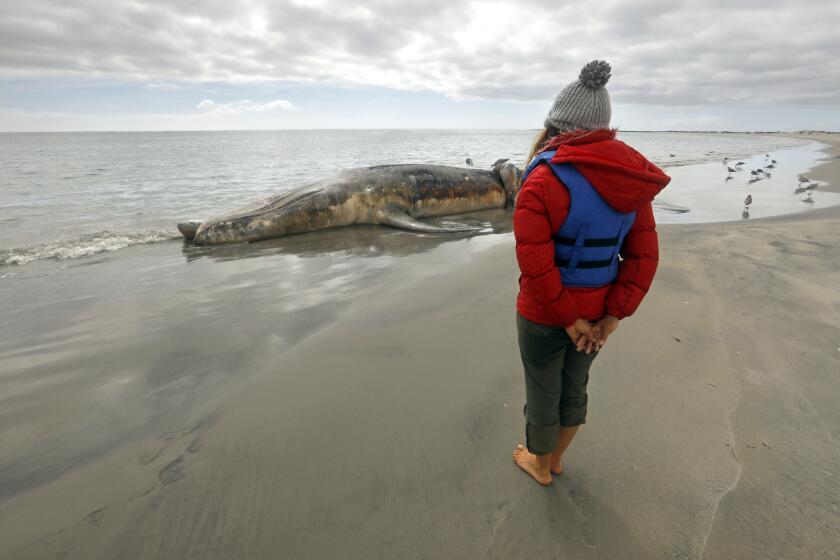As cargo shipments boom, ship strikes imperil whales in California and worldwide

- Share via
The 100-foot-long whale dived and circled in the murky, dark waters of the Santa Barbara Channel, looking for a cloud of krill to scoop and catch inside her 20-foot-long jaws.
As the blue whale began to resurface, whale scientist Brandon Southall was in a boat nearby, and he could feel his throat go dry. The whale was coming up right beneath a 200,000-ton transoceanic cargo ship, named the Maladarko, that was heading east from Hong Kong to its destination in Long Beach Harbor.
For the record:
3:03 p.m. Aug. 19, 2021A previous version of this article misstated the number of whales struck by ocean vessels between 2016 and 2020, according to a NOAA database of whale deaths. At least 112 showed injuries consistent with ship strikes, not 1,001.
3:03 p.m. Aug. 19, 2021
3:03 p.m. Aug. 19, 2021
“We were plotting the two paths,” said Southall, a researcher at UC Santa Cruz and the president of an Aptos-based marine biology research firm. “It was a straight collision course.”
With the increase of cargo and cruise boat traffic the last several decades, ships have become one of the deadliest threats whales face in open oceans and coastal waters. Ship strikes are not thought to be a predominant cause of the West Coast die-off of gray whales since 2019, but they are a factor, and an increasing concern.
Between 2016 and 2020, at least 112 beached or dead whales were identified by the National Oceanic and Atmospheric Administration as having “injuries consistent with ship strikes,” according to an informal NOAA database of whale deaths.
Earlier this year, horrific photos of two fin whales pinned to the hull of an Australian naval ship gained worldwide attention. The vessel had been conducting exercises in the waters near San Diego. The two bodies — one 65 feet long, the other just 25 feet — were draped over the hull.
“Anywhere you have major shipping routes and whales in the same place, you are going to see collisions,” said Russell Leaper, an expert with the International Whaling Commission. “Unfortunately, that’s the situation in many places.”

While gray whales and humpbacks make up 70% of the reported strikes in the government’s database, it’s the endangered and threatened populations — such as North Atlantic right whales and the gargantuan Pacific blues — that concern scientists the most. For those whales, each death comes with a risk of population or species extinction.
Southall and colleagues, including John Calambokidis at Cascadia Research Collective, examined behavioral differences in whales during day and night.
They discovered that whales tend to hang out closer to the surface at night and for longer periods of time. This was especially true for blue whales, making them particularly vulnerable.
Scientists are unsure if the whales are resting during the night or feeding on food sources that move closer to the surface during nighttime hours — when krill-eating seabirds and other marine animals are sidelined. But these behaviors add to the complexities of avoiding collisions through mitigation measures — such as keeping an eye out for whales while on a moving vessel.
“Having a lookout isn’t going to help,” said Southall, president of Southall Environmental Associates.
Tracking whales in 2020 was anything but easy. We had to pivot and find new ways to tell the story of a mass die-off along the Pacific coast.
What can make a difference, experts agree, is slowing down boat traffic — allowing whales not only the chance to flee, but possibly reducing the potential injury — and altering shipping lanes when whales are present.
Along the U.S. Atlantic Coast, mandatory speed restrictions during certain seasons have helped reduce right whale mortality. Conservation groups are asking the government to extend the regulations to boats smaller than 65 feet, as well as to expand the areas and times for these maximum speed limits.
Others are hoping to create protocols and communications systems that will allow boat captains, mariners and harbor masters to voluntarily reduce speeds and alter routes where whales are present — in real time.
Elliott Hazen, a researcher with NOAA’s Southwest Fisheries Science Center in Monterey, has developed an app that works like Google Maps — except instead of navigating cars and harried drivers around Los Angeles, it helps boats avoid concentrations of whales.
Using data collected from satellites on ocean temperature, food distribution and currents, WhaleWatch can predict “whale hot spots” and warn vessels approaching such critical areas — giving boat captains a tool and an extra incentive to slow down, and possibly alter their route.
“It’s predictive,” said Hazen. “Here’s where you are most likely to have concentration of whales.”
Gray whales have one of the longest migrations of any mammal and have proved themselves adaptable. But can they adjust to rapidly changing oceans?
Voluntary limits can only go so far. All researchers interviewed for this story said mandatory speed restrictions and route alterations are the best way to reduce whale mortality.
“One of the difficulties is that these cargo vessels, they have a small window of time to unload cargo,” Hazen added. “If slow speeds are not mandatory, there may be little incentive for them to slow down.”
Slower speeds also reduce the amount of fuel needed — making a voyage cheaper — and reduce the amount of carbon dioxide emitted into the atmosphere. “Slow speeds are a win for all,” said Leaper.
In the case of the leviathan observed in the Santa Barbara Channel, Southall and his colleagues had previously attached temporary trackers, via suction cup, to the female blue whale. The monitors were part of a study they were conducting in 2014 on the behavioral responses of whales to military sonar.
After their experiment was over, they waited around for the trackers to drop off.
“They’re expensive devices,” said Southall, noting their $20,000 price tag and the need to retrieve them.
Gray whales have been dying in record numbers. No one knows exactly why, but there are some clues.
They kept a safe distance from this whale, whom they had known since 1987. She had been involved in capsizing a 23-foot private vessel off the coast of Shelter Island near San Diego in 2014.
Suddenly, as they waited, they saw her shoot from the depths straight toward the cargo vessel’s trajectory.
“We watched, with our hands over our mouths, thinking, ‘Oh, my God, are we gonna see a strike? Or a pool of blood?’” Southall said.
But then she stopped, mid-swim, and rolled to her side, just a few meters below the hull — presumably to eyeball the behemoth cruising over her.
For the next three minutes, she remained suspended below, only resurfacing after the cargo ship passed.











